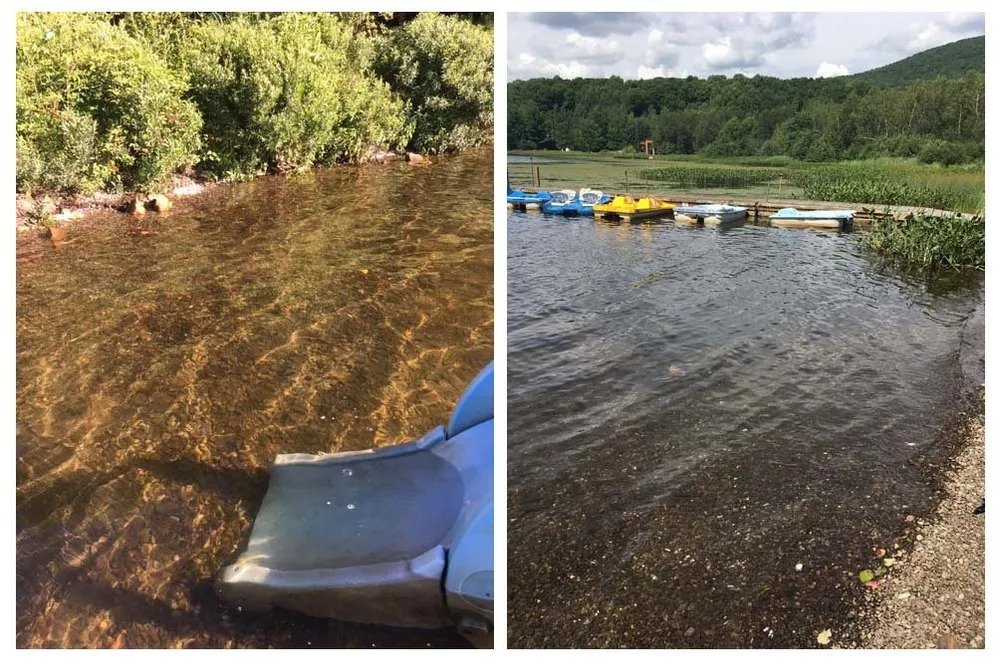22 Sep, 2020
Three years on: positive results for Lac Bromont
“The ACBVLB is an organization whose mission is to protect and rehabilitate the health of Lake Bromont and the ecosystems of its watershed”
Three years after an application of Phoslock, the results are looking positive for this lake in Quebec, 90 km to the east of Montreal.
The treatment of Lac Bromont with 179 tonnes of Phoslock in October 2017 was the first ever Phoslock treatment in Quebec. Water quality in Lac Bromont had long been of paramount importance to local residents and recreational users of the lake and a very active stakeholders association (the ACBVLB) was formed in 1989 with the aim of identifying and implementing measures to improve the ecological condition of the lake. The ACBVLB and the Town of Bromont worked closely with researchers from the University of Quebec a Montreal (UQAM) for many years investigating the causes of the blooms of the lake, before finally settling on Phoslock as the preferred method to reduce the phosphorus concentrations in the lake in order to help improve its water quality. In addition to Phoslock, considerable efforts were made to reduce external inputs of phosphorus to the lake.
Three years later and the positive effects of Phoslock are clear. According to Michelle Champagne, the President of the ACBVLB, “water transparency increased substantially between 2017 and 2019”, while Dolors Planas, a researcher and Professor Emeritus at UQAM says that “total phosphorus concentrations at the deepest point in Lac Bromont have decreased by more than 70% compared to the pre-Phoslock concentrations, despite the duration and extent of the oxygen deficit during these periods.” The lake is 7.2m deep and phosphorus would normally be released from sediments during periods when oxygen levels drop in the deeper zones of the lake. “To see such large declines in concentrations is a very encouraging result of the treatment” continues Mme Planas.
The development of Lac Bromont following the application has been summarized in a report and a press release issued jointly by the ACBVLB, UQAM and Laval University. Both can be downloaded from the Association’s website (www.lacbromont.ca). One of the most positive outcomes of the treatment has been that phosphorus bound through the Phoslock application has shown to be “sequestered in large quantities in the sediments of the lake after the treatment”, a clear sign that Phoslock has been successful. This result was observed across all sampled sediment sites in the lake, with the deepest sampling site storing phosphorous up to “five times greater than before treatment” (personal communication Wessam Neweshy, PhD student of Professor Couture at Laval University).
The monitoring program of the lake is in place for another 2 years to investigate long-term impacts post- application. Work also continues to assess the influence of external phosphorus inputs to the site and the long-term effectiveness of the Phoslock treatment. The application was supported by the Environmental Ministry of Québec (MELCC) and continues to serve as a pilot project for lake restoration in many lakes of the province.
It doesn’t take long scrolling down the Facebook page of the ACBVLB to realise just how passionate the local residents are about their lake – delightful photos show some of the nature of the lake and many more photos highlight the activities of swimmers across all age groups enjoying the water.

Prior to the treatment this recreational waterbody regular suffered from high phosphorus concentrations and poor water quality.

July 2020 photos: Anne Joncas
Sources:
ACBVLB, 2020. Lac Bromont press release 2020 (https://www.lacbromont.ca/)
Planas, et al., 2020. Lake restoration project Lac Bromont: review of the 2nd year of Phoslock pilot project.
Neweshy, et al., 2020. Devenir du phosphore dans les sédiments du Lac Bromont suite à un traitement de restauration au Phoslock®